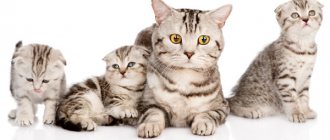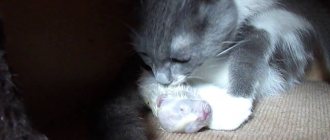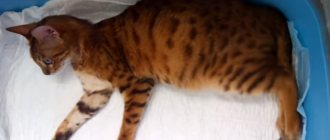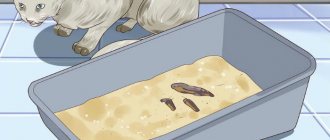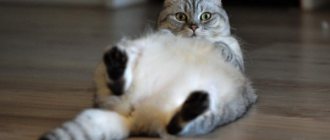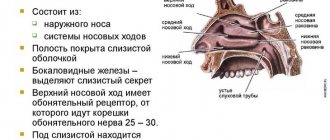On average, a cat reaches puberty between 5 and 12 months of age. In rare cases, a cat may become ready to conceive at 3.5 months. For other females, the maturation process may be delayed until they are 18 months old. If your cat has not started to come into heat after a year and a half, she needs to be seen by a veterinarian.
The following factors influence the age of puberty:
- weight;
- health status;
- conditions of detention;
- season;
- length of daylight hours;
- breed;
- heredity.
Often, in short-haired breeds, maturation occurs earlier - by 6 months, while long-haired breeds become ready for conception only at one year of age.
The cat's readiness to mate is marked by the onset of the first heat. During this period, the animal's behavior changes significantly.
Signs of estrus:
- The cat takes an unusual pose: it presses its front paws to the ground and raises its butt.
- The female cannot find a place for herself, walks all over the house and meows desperately.
- Refusal to eat.
- Insistent attention towards the owner, or vice versa, complete ignoring of him.
Although a cat can become pregnant during her first heat, her body is not yet fully prepared for such stress. Experienced breeders allow a female to be bred only on her second or third heat.
Breeders allow domestic cats to breed until the age of six. In rare cases, breeders also work with older cats for selection purposes. Since pregnancy at this age is associated with serious risks, only animals that are valuable for breeding (for example, an unusual phenotype) are allowed for breeding.
Signs of pregnancy
The first signs of pregnancy in a cat may appear 1-2 weeks after mating. They manifest themselves in changes in behavior, which are caused by changes in hormonal levels. The cat becomes less active. Appetite either increases or decreases. However, these signs may be completely absent in the early stages, or they may indicate not pregnancy, but a disease of the female.
Over time, the cat may begin to vomit. Behavior also changes. The pet either becomes more demanding of attention, or, on the contrary, may begin to avoid the owner. The nipples swell, the skin around them peels off, and fluid is released from them. The stomach becomes denser.
At week 5, the belly becomes significantly larger. After this, it will constantly increase in width. At week 7, when you touch the belly, you can feel the kittens moving.
Features of pregnancy
In cats, the opportunity for fertilization appears after the onset of puberty. For the first 6 months, the cat is considered a kitten, and you don’t have to think about pregnancy yet. But in order to further determine a cat’s pregnancy and its timing, you need to become familiar with the concept of estrus in an animal.
A cat's heat is the beginning of puberty.
A cat's heat is the onset of puberty, therefore the period when a cat can become pregnant for the first time. For the owner, this will be a signal about the animal’s ability to fertilize after mating with a cat.
Some features of the onset and course of pregnancy:
- During the year, a cat may come into heat 2-3 times;
- during the period of heat, the pet changes greatly in behavior: it falls to the floor and begins to rub its stomach and back, while meowing without stopping, it can rub against people, sometimes it makes marks around the house;
During the period of estrus, your pet changes a lot in behavior
- at the beginning of estrus, days 1 and 2, the cat loses its appetite, meowing becomes loud and intense, however, when meeting a cat these days, the cat may not let him near her, but after the first days of estrus, the cat will be ready for mating;
- It is quite rare to see a pregnant cat after the start of her first heat; fertilization usually occurs as a result of several meetings with the opposite sex;
If the owner has a need to sterilize a pet, then it should be remembered that this procedure is best carried out in a cat after pregnancy, first or secondary, it does not matter, the main thing is to know how to correctly determine the moment of puberty and only then contact a specialist.
How long does pregnancy last and how does it proceed?
In a cat, pregnancy lasts on average 60 to 65 days. The minimum permissible period for childbirth is 58 days, and the maximum permissible is 71 days.
The duration of pregnancy in a cat is influenced by the following factors:
- Female weight. Thin cats give birth earlier than overweight cats.
- How long does a cat bear fruit? The more kittens, the faster the birth will begin.
- The age of the cat and the number of births. The first pregnancy of a young female often ends in early birth and the birth of weak offspring.
- Breed. Short-haired breeds (Rex, Abyssinian, Russian Blue, Siamese) give birth to kittens 4-5 days earlier than long-haired breeds (Siberian, Neva Norwegian).
- Ordinary yard cats give birth to viable and completely healthy offspring earlier than purebred cats.
Normal pregnancy
How does a cat's pregnancy progress by week?
| Term | Appearance and behavioral changes | How the fetus develops |
| 1 Week | Slight decline in activity, change in appetite | Fertilization of the egg occurs and its attachment to the wall of the uterus |
| from 2 to 3 weeks | Vomiting, toxicosis, decreased appetite, significant decrease in activity | The placenta is formed. The embryo has a visible head and tail |
| 4 week | Nipples turn pink and swell. The cat requires attention and affection from the owner. The abdomen is slightly tight | The formation of internal organs occurs. On ultrasound, you can hear the kittens' heartbeat. The size of each baby reaches 20 mm |
| from 5 to 6 weeks | The abdomen is significantly rounded. When palpated, you can feel the fruits and their movement. The female sleeps and eats a lot | Development of bones, muscles, and nervous system occurs. The body is covered with fur, and claws appear on the paws. The size of babies is 40-60 mm. |
| from 7 to 8 weeks | The abdomen increases greatly in size. The movements of kittens can be seen with the naked eye. The cat goes to the toilet often. Eats small meals often | The fur is finally formed. The x-ray shows the formed bones and spine. Babies begin to develop reflexes |
| Week 9 | The stomach drops towards the hips. The cat begins to look for and arrange a nest. Appetite drops | Kittens reach a size of 13 cm. At 60 days of pregnancy they are completely ready for birth |
False pregnancy
In some cases, after mating, conception does not occur, or the embryos do not attach to the uterus. There is a hormonal imbalance in the cat's body. She begins to behave like a pregnant woman: she sleeps and eats a lot, sets up a place for lambing, her nipples swell. In the early stages, only a specialist can distinguish a real pregnancy from a false one using ultrasound.
A false pregnancy may occur for the following reasons:
- hormonal disbalance;
- heredity (breeds in which this problem most often occurs: Oriental, Rex, Sphynx);
- male sterility;
- psychological stress;
- excess weight;
- the presence of another pregnant cat nearby.
False pregnancy is not very dangerous for the female’s body if it is not a frequent occurrence. Constant hormonal imbalances can lead to diseases of the reproductive system. To reduce the risk of false pregnancy, the following measures should be taken:
- a non-sterile cat must participate in breeding;
- it is necessary to monitor the health of your pet;
- the diet must be balanced;
- You should protect your cat from stress.
Superfetation
Superfetation is a rare phenomenon that sometimes occurs in felines. It consists in the fact that an already pregnant cat may go into heat, resulting in fertilization again. Most often this happens due to hormonal imbalance in the body. In this way, the female will carry kittens conceived several weeks apart. Often the interval between conceptions is 3-6 weeks.
Most often, such pregnancies in cats have a sad outcome. Both litters are born together, which is why the younger, underdeveloped kittens die. Less often, a cat gives birth to older kittens first, and then younger ones a few weeks later. In this case, the owner may be faced with the problem of a cat’s lack of nipples and milk for the entire litter. The owner will have to supplement the babies artificially.
Frozen pregnancy
Sometimes some or all embryos die during fetal development. Only a veterinarian can make an accurate diagnosis after an ultrasound. Indirect signs that indicate a frozen pregnancy: the cat’s belly stops growing, the kittens do not move. If the kittens begin to decompose, intoxication of the body occurs: the body temperature rises, vomiting begins, and refusal to eat. If urgent measures are not taken and the embryos are not removed, the cat will die.
Sometimes, in the case of a frozen pregnancy, the cat immediately miscarries. Also, in some cases, if not all kittens died, the cat gives birth to babies on time. Dead embryos are released along with live kittens.
Period of active movements
Kittens begin to move around 5-6 weeks . At first they are quite rare, then the babies begin to move more and more often.
By this time, their paws and toes had already formed, skin had appeared on their body, and the first hairs had begun to sprout. During this period, babies develop their basic senses: hearing, touch, and smell. The nervous and muscular systems continue to develop.
© shutterstock
Features of pregnancy in the second half of the term:
- The cat's belly becomes quite noticeable, its shape becomes pear-shaped, since the kittens are located in the belly area. Moreover, if a cat is expecting 1-2 kittens, the belly may not be visible at all.
- At this stage, experienced owners can feel the heads and determine the number of kittens in the stomach. True, this is not so easy to do - especially when they begin to move a lot.
- Closer to the 7th week, it is already clearly noticeable from the outside how the kittens move, if the cat’s hair is not too long.
- The cat becomes more careful, avoids jumping from heights, seeks shelter, eats and sleeps a lot, and moves little.
- Kittens, as a rule, are quite mobile and move a lot during the day: they can stretch, make massaging movements with their paws, and push each other. When swallowing amniotic fluid, babies may hiccup – these movements can also be noticeable. If the litter is expected to be large, then at times it seems as if the cat’s belly is literally shaking.
At 7-8 weeks, the cat’s stomach becomes less and less space, and the kittens begin to move with a vengeance. The activity of children at times greatly disturbs the cat; she seeks solitude and hides in secluded corners. At this stage, you can easily feel how the babies move through the wall of the abdomen - you just need to put your hand.
Diagnosis of pregnancy and precursors of childbirth
External symptoms of pregnancy may be false. In the early stages, only a veterinarian can diagnose pregnancy.
The following diagnostic methods exist:
- Blood test for hormones. Until the 30th day of pregnancy, the amount of progesterone in the blood increases significantly. 25 days after ovulation, the level of the hormone relaxin increases in the body.
- Palpation. At day 25 of pregnancy, the doctor can feel the embryos in the cat's abdomen.
- From 3-4 weeks, an ultrasound will help determine pregnancy.
- On the 40th day after mating, the skeletons of the kittens are visible on x-ray.
- A stethoscope can help you listen to the heartbeat of kittens in late pregnancy.
You should not palpate the cat’s belly yourself, as this can harm the female and kittens.
Signs that will help you understand that your cat is going into labor:
- The female eats less than usual or refuses to eat at all.
- The cat is acting restless and rushing around the house.
- The cat constantly licks the area between its hind legs.
- Breathing becomes frequent and shallow, shortness of breath appears.
Sensing the approach of birth, the cat will settle in its nest and will not leave until everything is over.
How to determine the gestational age of a cat
A gradually increasing belly makes many owners nervous and worried. For greater peace of mind, you can keep a calendar until your cat gives birth. However, this method is suitable for those who approximately or exactly know the moment of conception.
Pregnancy of a Chihuahua by day and childbirth in a dog
Pregnancy is determined and significantly manifests itself already on days 16-18. The belly gradually grows, the nipples swell and become darker. The expectant mother's appetite increases, which undoubtedly affects her weight.
However, these are only visual signs that can tell the owner little. A pregnancy calculator can help you determine when your cat will give birth. Such programs are available on the Internet and are quite easy to use. However, the owner will also need information about the day of mating.
Important! If there is no information about conception, only a veterinarian can tell you a more precise date.
Rules and features of caring for a pregnant cat
Pregnancy is a complex process when the female body spends a lot of energy to bear healthy offspring. This is why a pregnant cat needs special care. Your pet needs to be protected from stress and anxiety. If there are small children living in the house, you need to explain to them so that they do not bother or pick up the cat.
A pregnant cat should not jump to great heights. Therefore, it is better to temporarily block access to cabinets, refrigerators and high shelves.
A pregnant cat should not be vaccinated or given anthelmintics. Prevention of infectious and parasitic infections should be taken care of before mating.
A pregnant cat should be played with, as a decrease in activity can lead to obesity. But you can’t overwork your pet. As soon as the cat gets tired, she needs to be given the opportunity to rest.
It is important to isolate the cat from the cat not only before birth, but also after. A cat can become pregnant again even while nursing kittens. In some cases, females are ready to breed again 1.5-2 weeks after giving birth. A second pregnancy will not have the best effect on your pet’s health.
Shelter and nest for a pregnant cat
The cat should have its own quiet and secluded place where it can rest peacefully. It is better to place the bedding or house in a closed place, protected from drafts and direct sunlight. If the female finds the place secluded and protected enough, she will give birth to kittens there.
2 weeks before lambing, you can place a pre-prepared “nest”. It can serve as a cage, arena, exhibition tent or an ordinary cardboard box. A light cloth or diaper should be placed at the bottom. If the apartment is cold at the time of birth, a warm heating pad should be placed in the nest. They shouldn't be too hot. There must be drinking water near the house.
If the cat chooses another place to give birth, you should not move it.
Diet
Much attention should be paid to the pet's diet. A cat that eats commercial food should be switched to special food for pregnant women. If your pet eats natural food, low-fat fermented milk products, liver, and cereals should be included in the diet. Also, after consulting a veterinarian, the female should be given additional vitamins and mineral supplements. Serving sizes should be appropriate for the size, age and breed of the cat. You cannot overfeed the female, otherwise she may develop obesity, which will have a bad effect on pregnancy. Since growing kittens slightly compress the stomach, you should feed your pet more often. In this case, the daily portion of food can be increased by no more than 10%.
How to help a cat during and after birth?
Most often cat births
can last from 6 hours or more, you should try to stay close to the animal during this time, since the presence of the owner nearby will calm the cat. You can often hear advice about cutting the umbilical cord of kittens and wiping them with napkins, but a cat can handle this on her own, even one that is giving birth for the first time.
The place for childbirth must be taken care of in advance. The box and bedding chosen for the cat should be quite large so that the animal can easily change its position, lie down, and turn around. Often a cat after giving birth
strive to hide the offspring in hard-to-reach places, so the owner should try in advance to limit the animal’s access to linen, the contents of cabinets, shelves, beds and the space under them.
In order for a cat to feel safe, she and her kittens should have a comfortable place in a quiet and peaceful corner of the house. At the same time, the owner should monitor the cleanliness of the litter (especially in the first days after birth), the presence of a bowl of clean water nearby, and the bowl of food should be placed closer to the animal; in the first days after birth, the cat
is reluctant to leave the kittens even to eat. A nursing cat should eat high-quality and healthy food, while giving preference to wet food - their consumption has a better effect on the animal’s lactation.
Complications during pregnancy
Pregnancy is a complex process associated with great risks to the life and health of the pet. The cat's well-being should be closely monitored throughout pregnancy.
Symptoms that should promptly contact a veterinarian:
- Complete refusal to eat, which lasts more than a day.
- Apathy, weak reaction to stimuli.
- Significant increase or decrease in body temperature.
- Heavy, intermittent breathing.
- Discharge from the loop. The liquid may be pink, red, green or yellow. It may smell unpleasant.
Premature birth and post-term pregnancy are equally dangerous for a cat. If kittens appear earlier than 56 days after conception, the birth is considered premature. Kittens that the cat has carried for at least 50 days can be released. If the babies appeared earlier, they will die.
A pregnancy is considered post-term if the babies have not appeared on the 70th day after conception. Most often, the absence of birth indicates that the kittens have died. In this case, the cat needs urgent surgery, otherwise sepsis may develop. Sometimes cats carry live kittens to term, and the babies are born quite healthy, only later. In any case, only a doctor can find out exactly the cause of a post-term pregnancy using an ultrasound.
Symptoms of the onset of labor
Early warning signs of childbirth are sagging of the abdomen as a result of relaxation of the ligaments, as well as retraction of the sacral region.
On the eve of delivery, swelling of the genital organs and mammary glands occurs, and droplets of colostrum are released. Viscous mucus without pathological impurities comes out of the loop.
Read the article about bleeding in a pregnant cat.
When labor occurs, the water breaks, releasing a grayish-pink fluid. Then contractions appear, which normally last for an hour, which, if the outcome is favorable, end with the birth of offspring.
Artificial termination of pregnancy
There are often no medical indications for induced abortion in cats. Non-viable kittens themselves die in utero. Then they come out naturally or are removed surgically. In most cases, a cat has an abortion at the request of the owner.
There are two types of abortion in cats: medical and surgical.
Medication
- At 3-6 weeks of pregnancy, the cat is given prostaglandins, which cause miscarriage.
- At 6-9 weeks, abortion is performed using glucocorticoids.
Surgical
- Without sterilization: incisions are made in the uterine horns through which the fetuses are removed. The operation is performed on days 15-36 of pregnancy. This is a complex and expensive surgical procedure.
- With sterilization: the uterus and ovaries are removed. The operation is performed before the 7th week of pregnancy.
Often, medical abortions also end in surgical intervention due to the high risk of complications.
Abortion in most cases leads to the loss of reproductive function in the cat. In addition, the animal receives serious stress. Therefore, it is better to sterilize your cat before she becomes pregnant.
The female spends a lot of her body’s resources on pregnancy and childbirth. To ensure that cats have time to recover, experienced breeders breed them no more than once a year. It is worth noting that this process does not add health to the animal, but rather shortens the life of the female and puts her at risk of various complications. That is why it is worth breeding only animals that have value for breeding work. It is better to sterilize outbred cats.
